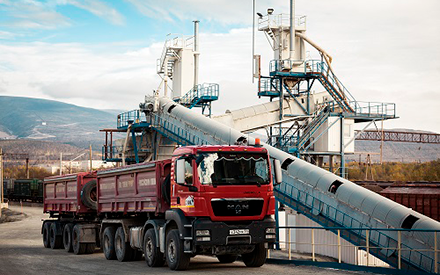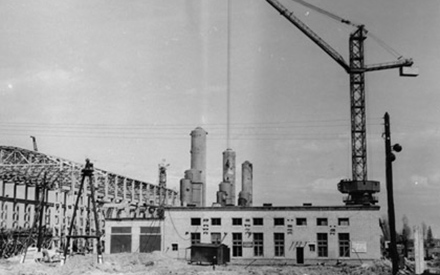Acron Group is a fast-growing company. At the core of the Group are two production facilities, Acron plant and Dorogobuzh plant, which at one time formed the basis of the Soviet fertiliser industry.
2021 — 2011
Sustainable
development
2021
Acron Group stepped up construction of the Talitsky potash mine in Perm Krai.

Acron completed a full-scale upgrade of the Urea-6 unit at the Veliky Novgorod site, having increased its capacity from 600 to 2,050 tpd.
Acron launched an online fertiliser trading platform for Russian growers.
2020
The third 135,000-tpa nitric acid unit was put into operation at Acron in Veliky Novgorod.

Acron launched a new 700,000-tpa urea granulation unit.
With Acron’s support, a modern geriatric centre was opened in Veliky Novgorod.
Acron in Veliky Novgorod completed the project to expand Ammonia-4 capacity to 2,550 tpd.
2019
Acron Group made several management changes: Evgeni Sozinov was appointed the new CEO of North-Western Phosphorous Company, and Oleg Tikhonov was appointed Dorogobuzh’s Executive Director.

A new 135,000-tpa nitric acid unit was put into operation at the Group’s facility in Veliky Novgorod.
Acron Group participated in the St. Petersburg International Economic Forum and signed a number of important agreements.
Acron Group signed a Special Investment Contract to create an industrial-scale potassium chloride production facility in Perm Krai.

Acron Group, VEB.RF, Gazprombank and Sberbank signed the preliminary terms and conditions for funding the development of the potassium-magnesium salt deposit in Perm Krai.
The second 135,000-tpa nitric acid unit was put on stream at Acron (Veliky Novgorod).
Acron Group participated in the Moscow Region Field Day and Bryansk Field Day agricultural exhibitions.
Acron Group participated in the Moscow Region Field Day and Bryansk Field Day agricultural exhibitions.
Acron Group took part in Golden Autumn agricultural trade show.
Acron and NWPC won the Company of the Year award in the Industrial Leader nomination.
VEB.RF Supervisory Board approved financing for Acron’s project to develop the Talitsky area of the Verkhnekamsk potassium-magnesium salt deposit in Perm Krai.
2018

Acron Group renamed its export trading companies in Switzerland and the USA as Acron Switzerland AG and Acron USA Inc.
North-Western Phosphorous Company commissioned a railroad section connecting the Oleniy Ruchey mine and the main railroad.
Acron launched a new NPK 18-6-18+2Mg+2S fertiliser brand.
Acron Group set up two distribution companies — Acron Brasil Ltda in Brazil and Acron Argentina S.R.L. in Argentina.

Acron Group attended the Golden Autumn Trade Show in Russia.
Acron Group commissioned a new 600-tpd urea unit at its Veliky Novgorod site.
2017
Acron Group acquired a distribution and logistics complex Millerovo Interdistrict Selkhozkhimia in Rostov region. With this 12th agrochemical facility within Agronova, the Group has increased its total storage capacity to 189,000 tonnes.
Acron celebrated its 50th anniversary.
Acron won a high-profile annual environmental contest, Russia’s Top 100 Organisations: Ecology and Environmental Management. Acron executive director Vladimir Gavrikov was awarded the badge of honour for 2017 Environmental Specialist of the Year.
Acron Group plans to build the sixth urea unit at Acron site in Veliky Novgorod. The new urea plant capacity will be 600 tpd.

Acron in Veliky Novgorod completed an overhaul at its Main Step-Down Substation-100 at a cost of RUB 300 mn.
Veliky Novgorod-based Acron held an Innovation Day event to promote leading-edge approaches to the facility’s operations and implement its talent agenda.
Acron commissioned the Plodorodie-Lukoyanov Agribusiness Facility in Nizhny Novgorod region.
Acron and the Smolensk regional administration signed an agreement to build a new complex mineral fertiliser facility. The project-related investments will total approximately RUB 25 bn.
Acron set up Acron France SAS, a distribution company in France.
Acron CEO Vladimir Kunitsky was awarded the badge of honour for the title of Honoured Chemist of the Russian Federation.
Acron produced the first million tonnes of product at its Amonnia-4 unit in Veliky Novgorod.
Dorogobuzh won the prize for promoting healthy lifestyles at an industrial organisation as part of national Socially-Conscious Business contest sponsored by the Russian Ministry of Labour and Social Protection
2016
Acron Group and the Kurchatov Institute National Research Centre signed an agreement on cooperation in fundamental and applied research.
Acron bought back a stake in the Talitsky potash project from Eurasian Development Bank.
Acron sold its stake in Uralkali.
Acron’s project to construct the Talitsky mine was named a priority investment project in Perm Krai.
Acron launched a new 700,000-tonne Ammonia-4 unit at its site in Veliky Novgorod.
Acron inaugurated rare earth elements operations in Veliky Novgorod.

NWPC completed the first stage of the Oleniy Ruchey mine and reached the design capacity.
Acron Group sold its stake in Chinese producer Hongri Acron.
NWPC embarked on building a railroad in Murmansk region.
2015
.jpg)
Acron Group signed six agreements with regional departments of agriculture to supply 1 million tonnes of mineral fertilisers in 2015.
On 21 May 2015, Acron held annual general meeting.
Fitch Ratings improved Acron Group’s credit rating to BB-/Stable.
Acron Group’s subsidiary VPC received a positive finding from the expert review board (FGU Glavgosekspertiza) for design documentation to construct the Talitsky mine.
Joint Stock Company Dorogobuzh was renamed Public Joint Stock Company Dorogobuzh.
Moody’s international rating agency improved Acron Group’s credit rating to Ba3/Stable.
On 3 December 2015, Perm Krai Minister of Economic Development held a business meeting with Chairman of Acron Board of Directors to discuss prospects for a major investment project to construct the Talitsky mining and processing facility in Perm Krai.
2014
.jpg)
Acron’s Novgorod facility reaches 1 million tpa UAN capacity.
Acron Group attracts Sberbank Investments Limited as a new investor for the Talitsky potash project. Sberbank Investments Limited acquires a 19.9% stake in Verkhnekamsk Potash Company (VPC).
The Group starts shipping apatite concentrate to third-party consumers.
Based on the exploration results Acron Group and Rio Tinto Group form a joint venture company to develop Albany potash prospect in Saskatchewan.
2013

The Oleniy Ruchey mine reaches apatite concentrate output of 60 ktpm. NWPC fully covers the phosphate input demand of Acron Group companies.
NAP completes exploration of the potash deposit at the KP 405 permit in southern Saskatchewan (Canada) operated by a joint venture with Rio Tinto Potash Management Inc.
Acron (Veliky Novgorod) obtains state approval for Ammonia 4 project and a construction permit for a new 700 ktpa ammonia unit.
Dorogobuzh launches a new soft container production line.
AS DBT port terminal complex commissions three additional dome-shaped warehouses for bulk blends with a total capacity of 27 kt.
2012
NWPC starts shipping apatite concentrate manufactured by the Oleniy Ruchey mine while it operates in a test mode.
VPC obtains approval from GlavGosExpertiza and starts construction of vertical shafts at the Talitsky mine.
Acron Group raises funds for the project from Vnesheconombank, Eurasian Development Bank and Raiffeisenbank, which acquired 38% of VPC’s authorised capital.
Acron (Veliky Novgorod) commissions a new 350 ktpa urea unit.
Acron Group acquirs a 12.03% interest in the authorised capital of Polish Azoty Tarnów.
2011

The construction of facilities, open pit and entrance mine galleries at Oleniy Ruchey mine are in progress. First objects at the construction site are commissioned.
Acron starts preparing a project design and construction site for the new 700 ktpa Ammonia 4 unit.
VPC signs a general design contract with Belgorchimprom for the Talitsky mine. The 5.1 kilometre service road to the Talitsky construction site is built.
Acron Group adopts the Fair Work Programme to define its social support, environmental and public relations policies.
2010 — 2001
Vertically integrated
holding
2010

Acron Group embarks on construction of the Oleniy Ruchey mine. Foundations for most facilities at the site are completed, and construction of processing plant and ancillary facilities, open pit and tailing dump begins.
Komatsu mine equipment is purchased and put into operation, including excavators, bulldozers, loaders and heavy vehicles. A crushing and screening unit is purchased and a concrete mixer is commissioned to provide construction materials.
2009
AS BCT launches a 1 mn tpa ammonia transshipment complex. AS BCT is the second specialised ammonia storage and transshipment terminal on the Baltic Sea.
Acron Group sets up in Switzerland a distribution company Agronova Europe AG.
Standard&Poor’s puts Acron on its top ten list of the most transparent Russian companies.
Fitch Ratings assigns Acron a credit rating for the first time.
2008
Acron’s subsidiary Verkhnekamsk Potash Company wins licence to develop the Talitsky area at the Verkhnekamsk potassium and magnesium salt deposit.

Acron overhauls Ammonia 2 unit, bringing it to the first place in Russia in terms of efficiency of natural gas consumption and the second place in terms of ammonia output.
Acron’s Global Depositary Receipts (GDRs) are admitted to trading at LSE. Acron’s shares are admitted to B quotation lists at MICEX and RTS.
Acron (Veliky Novgorod) acquires a 50% interest in AS DBT port terminal facility for mineral fertilizer transshipment.
AS BCT terminal facitity launches a 1 mn tpa UAN transshipment complex in the Estonian port of Sillamäe.
North-Western Phosphorous Company obtains positive finding from state expert review and a permit to build a mine at Oleniy Ruchey apatite-nepheline ore deposit.
2007
Acron (Veliky Novgorod) launches production of a liquid fertilizer UAN with a capacity of 700 ktpa.
2006
Acron’s subsidiary North-Western Phosphorous Company obtains subsoil licences to mine apatite-nepheline ore at Oleniy Ruchey and Partomchorr fields in the Murmansk region.
Acron (Veliky Novgorod) opens formalin/urea-formaldehyde resin and amino resin facilities (75 ktpa and 105 ktpa respectively).
2005

Acron (Veliky Novgorod) consolidates 50.5% of its stock in Shandong Chemical Hongri Acron, Ltd., a Chinese complex fertiliser producer. Hongri Acron commissions a bulk blend unit with a capacity of 200 ktpa. Construction of a methanol production line with a capacity of 100 ktpa is commenced.
Ammonia facility at Acron (Veliky Novgorod) commissions Russia’s first computerised training simulator.
2004
Dorogobuzh’s AN unit commissions a new bulk blend facility with a capacity of 200 ktpa. Company starts shipping its products in big bags.
Acron launches new NP 32-6 facility for industrial production.
2003
Industrial production of low-density and technical-grade AN is launched.
Acron rebuilds ammonia synthesis reactor to increase its efficiency by 25%.
Acron acquires a 50% stake in Acron-Trans, a licenced railway operator.
2002

Dorogobuzh launches a new liquid carbon dioxide production unit.
2001
Det Norske Veritas certifies Acron quality management framework for compliance with ISO 9001-94 standards and issues a certificate for “Design, development and manufacture of chemical products at NPK and ammonia production facilities”.
2000 — 1991
Privatisation
and restructuring
2000

A-KANG trademark is registered in China for NPK fertilisers produced by Acron and Dorogobuzh and imported to the country.
1999
.jpg)
The Company hosts the first Russian Technical Meeting of the International Fertilizer Industry Association (IFA).
1997
The Company wins Best Russian Company Award for Outstanding Efficiency in Using All Types of Resources in a competition held by the Russian Union of Industrialists and Entrepreneurs, the Russian Chamber of Commerce and Industry, and Expert magazine.
1996
The Company starts building a distribution network in key Russian agricultural regions and creates a marketing group and research and development team.
1991–1995
.jpg)
1991–1995. Acron and Dorogobuzh are privatised. The large-scale restructuring and reconstruction of two companies’ business and management is completed. Acron and Dorogobuzh adopt the long-term reconstruction and upgrade programme and consolidated corporate governance system.
1990 — 1967
Industry leader in the USSR
1984
Dorogobuzh starts producing concentrated nitrogen-phosphorus-potassium fertiliser (NPK).
1982

Production of concentrated nitrogen-phosphorus-potassium fertiliser (NPK) is launched at Acron (Veliky Novgorod).
1979–1980. AN unit is commissioned at Dorogobuzh.
1979 год
Large-tonnage ammonia unit is launched at Dorogobuzh.
1977
AN production unit is commissioned at Acron (Veliky Novgorod).
1975
Two large-tonnage ammonia production units are put on stream at Acron (Veliky Novgorod).
1973

Urea-formaldehyde resin production facility is commissioned at Acron (Veliky Novgorod).
1970
Urea production facility is launched at Acron (Veliky Novgorod).
1969
The first ammonia and liquid ammonia production facility is completed.
1967

Air-separation and methanol production facilities are commissioned at Acron (Veliky Novgorod).